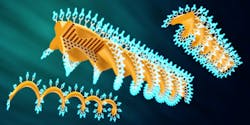Two-photon polymerization produces micrometer-sized swimming actuators for bioscience
| Microactuators of differing helical shapes are produced via two-hoton polymerization. The swimming actuators can be coated with active biological compounds. (Illustration: Peters C et al. Advanced Functional Materials 2014, reprinted with permission of Wiley) |
Using two-photon polymerization along with directed nanoparticle self-organization, researchers at ETH Zurich (Switzerland) have created microscopic actuators that swim through fluids and can carry bioactive molecules.1
The elongated actuator elements possess a helical shape and are driven by an external rotating magnetic field; they align themselves along the magnetic field lines and rotate about their longitudinal axis. Due to their shape, they swim via wobble-free corkscrew motion.
Microscopic 3D printing
The scientists used a light-sensitive, biocompatible epoxy resin in which they incorporated magnetic nanoparticles. In the first part of the curing stage, they exposed a thin layer of this material to a magnetic field, which magnetized the nanoparticles, leading to a particle rearrangement in the form of parallel lines. The researchers then manufactured the tiny elongated structures out of the modified epoxy film via two-photon polymerization, in which a laser beam was moved in a computer-controlled, 3D path within the epoxy resin layer, thus curing the resin locally. Uncured areas were then washed away with a solvent.
The resulting helical structures are 60 μm in length and 9 μm in diameter and have a magnetization perpendicular to the longitudinal axis. A conventional manufacturing method would not have allowed the production of an object with such magnetic properties, as the preferred magnetization is usually in the direction of the longitudinal axis of an object.
Previous microactuators usually took the shape of a corkscrew, but the ETH scientists were able to produce modified shapes similar to twisted strips and double-twisted wires. Tests showed that these forms swim as fast as corkscrew-shaped actuators; however, the new shapes differ from the latter in that their surface is two to four times larger, enabling them to carry heavier loads of bioactive molecules such as antibodies.
REFERENCE:
1. C. Peters et al., Advanced Functional Materials (2014) doi: 10.1002/adfm.201400596
